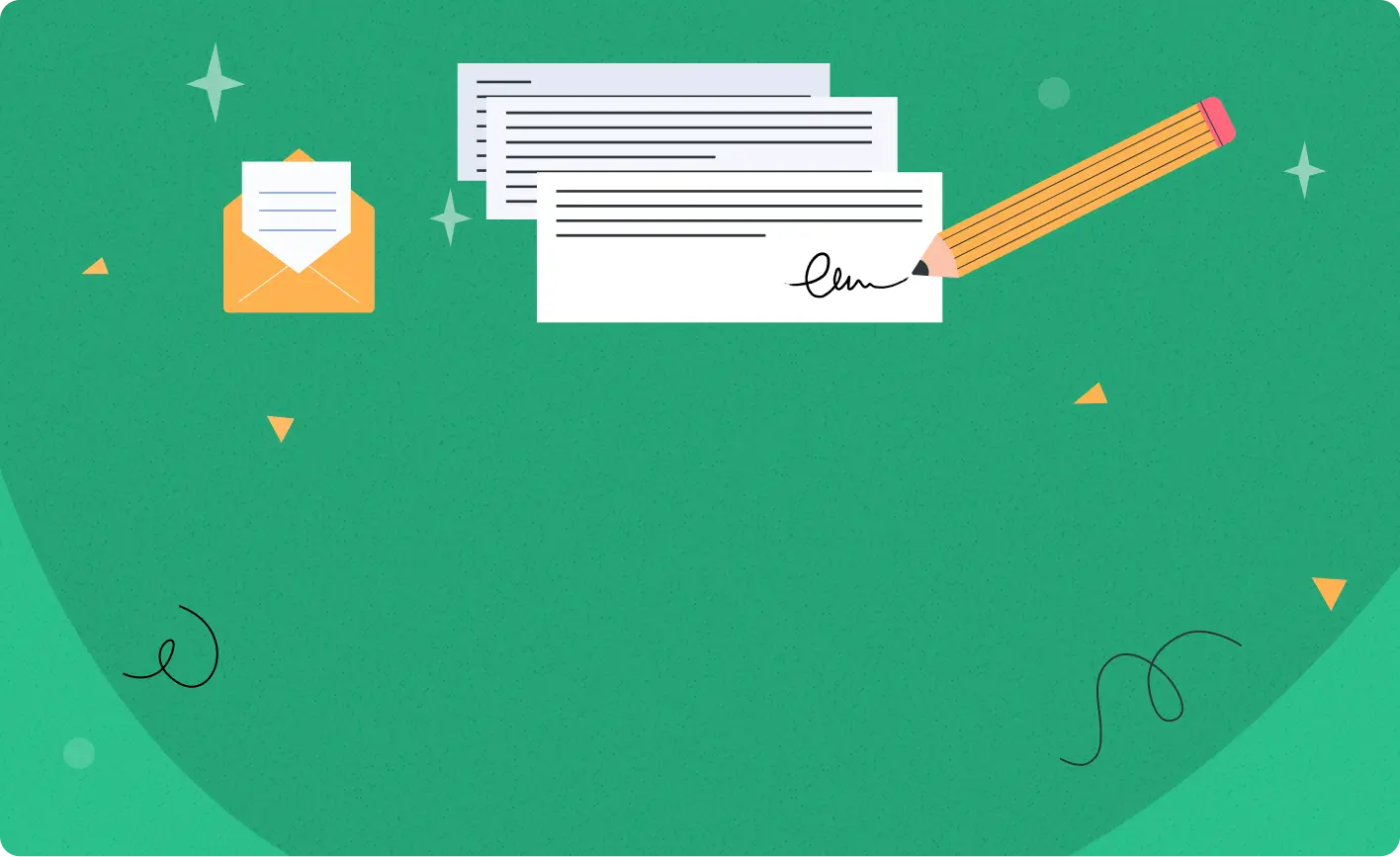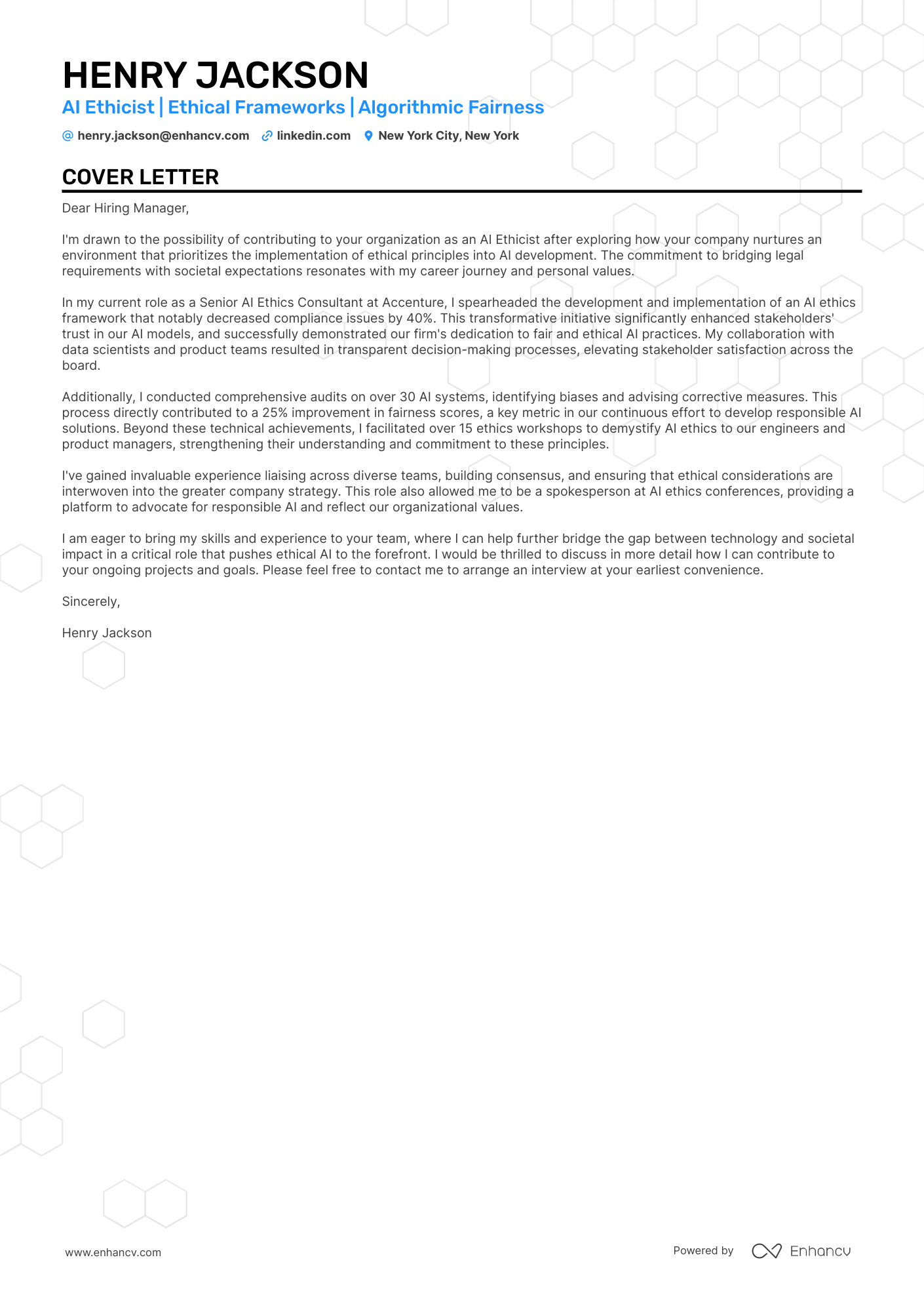You’ve probably heard “you need a cover letter if you’re applying for a job.” But what exactly is one, and what’s its purpose? Does anyone even read them in 2026? And if they do, what are they looking for?
Most applicants treat the cover letter as some kind of tired formality. But here’s the thing—a cover letter isn't just about introducing yourself. It can be used strategically to improve your chances of getting job interviews.
In fact, cover letters help some candidates get interviews—74% of hiring decision-makers prefer job applications with cover letters.
Understanding exactly what a cover letter is—and what it’s meant to do—could be the difference between getting ignored and getting hired.
Let’s break it down.
Key takeaways
- A cover letter is one of several so-called application letters.
- There are different types—which one you should use depends on your specific situation.
- Use one to grab the attention of hiring managers by showing your personality and passion for the role.
- When preparing your document, stick to established design and format best practices.
- Even if it isn’t required, including one can give you a strategic advantage.
What is a cover letter?
A cover letter is a short, personalized document you submit with your resume when applying for a job. Typically, it’s between 250 and 400 words. Its purpose is to formally introduce yourself to the employer and explain why you’re interested in the position.
While your resume lists skills, work history, and accomplishments, your cover letter tells the story behind your professional journey.
It also gives you an opportunity to connect with hiring managers on a more personal level. This will persuade them to take an in-depth look at your resume and consider you for the role not just because of your qualifications but your character as well.
You can think of it this way:
- Your resume is about what you’ve accomplished.
- Your cover letter is about what motivated you to accomplish it.
Is it important to have a cover letter?
We highly recommend writing a cover letter when you apply for a job. Some hiring managers actually read it first and decide whether or not to review your resume based on its content.
Besides, it can give you a strategic advantage over other candidates who skipped this “formality.”
Here’s what a good cover letter does for you:
- Creates an emotional connection with the hiring manager.
- Helps you stand out in a crowded applicant pool.
- Sets the tone for your application.
Does taking the time to create a cover letter feel like extra work?
Well, one of the harsh realities of job searching is that not all hiring managers will take the time to carefully read the documents you sent, no matter how invested you were in preparing them. Still, they’ll at least skim through your cover letter.
Moral of the story
It’s better to have a cover letter and not need it than the other way around. To streamline your efforts, create a general cover letter—one that you can easily copy and tweak for the roles you’re interested in.
So, what does a cover letter look like?
Cover letter example and breakdown
We used Enhancv’s free AI Cover Letter Generator to create a sample cover letter to inspire you.
At a glance, a cover letter is a pretty straightforward document. But if you actually take a moment to read its content carefully, you’ll notice that every line serves a purpose.
Let’s take a closer look.
Cover letter format best practices
So what’s in a cover letter? Your document should follow a clear structure that makes it easy for hiring managers to read it, as shown in the example above.
We recommend having these sections in the following order:
Cover letter header (contact block)
The cover letter header sets a professional tone and ensures the letter will reach the right person.It’s usually best to simply copy-paste your resume header.
The top of your cover letter is where you put your:
- Name
- Phone number
- Email address
- Date
Below that, add the employer or hiring manager’s:
- Name
- Title
- Company name
- Company address (if applicable)
Salutation
Whenever possible, address the cover letter to a specific person using “Dear [Hiring Manager’s Name].”
If you can’t find out what their name is, then use “Dear Hiring Manager.”
Avoid outdated salutations such as “Greetings”, “Dear Sir/Madam”, and “To Whom It May Concern.”
Opening paragraph
Here’s how to start your cover letter: grab the reader’s attention by clearly stating the position you’re applying for. Then, hint at why you're perfect for the job by mentioning your key achievements, a mutual connection, or your enthusiasm for the job.
Example:
I’m excited to submit my application for the Marketing Coordinator position at GreenLeaf Media. With a proven track record in digital content strategy and brand storytelling, I’m eager to bring my creativity and results-driven mindset to your team. I’ve long admired GreenLeaf’s commitment to sustainability in media campaigns, and I’m confident my background and passion for purpose-driven marketing make me a strong fit for this opportunity.
Body paragraphs
The body of your cover letter is where the real value lies. This is your opportunity to share a compelling story with the hiring manager — one that piques their interest in you and can’t be easily conveyed through resume bullet points.
Example:
In my previous role as a Marketing Coordinator at BrightEdge, I led a team project that increased organic website traffic by 40% within six months — all by developing a new SEO strategy and refreshing outdated content. This experience not only sharpened my technical marketing skills but also strengthened my ability to manage tight deadlines and collaborate across departments.
Beyond the numbers, I’m known for my creative problem-solving and genuine enthusiasm for turning ideas into campaigns that get results. I love working in fast-paced environments where new ideas are encouraged, and I believe this mindset aligns well with GreenLeaf Media’s mission to build innovative, purpose-driven brands.
Closing paragraph
It’s best to end your cover letter with a clear, polite closing paragraph. You can reaffirm your interest in the role, thank the reader for their time, and include a call to action—typically expressing your readiness for an interview. Don’t forget a polite sign-off at the end.
Example:
Thank you for considering my application — I’m excited about the possibility of contributing my marketing experience and passion for sustainability to GreenLeaf Media. I’d love the chance to discuss how my skills and ideas can support your upcoming campaigns and help grow your mission-driven brand. I look forward to the opportunity to speak with you soon.
Best regards,
Tony Cash
Enclosure and reference lines
An enclosure line appears after your signature and indicates that additional documents are attached (such as your resume or portfolio).
Example:
“Enclosure: Resume”
This helps ensure the reader knows to look for accompanying materials.
Optimize readability
Use clear headings, and enough contrast between text and background.
Make your layout easy to read on all devices:
- Margins: From 0.5 to 1 inch on all sides is a safe bet. Ensure they match your resume.
- Line spacing: Use single spacing within paragraphs. Add a blank line between paragraphs.
- Alignment: Left-align the text as this is the professional standard.
PRO TIP
The ideal length for a cover letter is one page—typically between 250 to 400 words.
Keep it short and sweet: focus on your most relevant qualities, tell a compelling story that shows what makes you great for the role, and invite the hiring manager to check out your resume.
File format
The best file format for a cover letter is PDF because it preserves your design choices across all devices. However, it’s wise to double-check the job posting because some employers specifically request a DOCX (Microsoft Word) file.
Cover letter design best practices
Cover letter formatting matters. A clean, professional-looking document makes a great first impression and guarantees your message is easy to read.
Here are the key cover letter design and layout best practices:
Aim for a clean, minimal look
Stick to a single-page format with plenty of white space. Use clear headings and short paragraphs. Avoid heavy graphics or complex layouts that could confuse ATS software.
Choose a modern font
Use a clear, professional font such as Arial, Calibri, Helvetica, or Rubik. The best font size is usually 11 or 12 points.
Use a subtle splash of color (optional)
A touch of color can make your letter stand out while staying professional. Stick to muted, neutral shades that match your personal brand or resume style.
Match your resume style
For a polished, cohesive look, use the same font, color scheme, and header design as your resume. This helps reinforce your personal brand.
Types of cover letters and when to use them
There are different types of cover letters, based on purpose, structure, content, and tone. What type of cover letter is best for you depends on your goals and what you’re applying for.
Let’s unpack this:
Cover letter variations
| Type | Purpose |
|---|---|
| Cover letter for job application | This is the standard type of cover letter most job seekers use when applying, as explained in the previous sections. |
| Internship/Scholarship/Grant cover letter | These typically focus on education, passion for the field, and future goals. Such letters emphasize motivation, transferable skills, academic accomplishments, and how the opportunity fits the career path of the applicant. |
| Creative/Acting/Portfolio/Upwork cover letters | For creative fields, the tone can be a bit more casual or expressive, but you still need to clearly outline your experience, style, past work (portfolio), and give a good reason why you’re perfect for the role. |
| Networking cover letter | It’s used when reaching out through professional contacts to inquire about job opportunities or ask for advice. |
| Referral cover letter | This variation strongly relies on mentioning a mutual connection—one who has recommended you for the role, which usually greatly increases your chances for landing an interview. |
Cover letter vs. other application letters
A cover letter is often confused with some of the other types of letters that can be part of the job-finding process.
Let’s take a look at how they differ from a cover letter:
Other application letters
| Breakdown |
|---|
| Letter of interest: It’s used when you want to express interest in working for a company, even if they don’t currently have an opening. |
| Motivational letter: It’s similar to a standard cover letter but it’s more common in applications for academic programs, scholarships, volunteering, and internships. The focus here is on motivation and passion. |
| Introduction statement: This is a very short paragraph or sentence (often used in networking emails) that briefly introduces you and your career goals. It isn’t a full formal document like a cover letter. |
Common cover letter pitfalls
Of course, there are common pitfalls in writing a good cover letter. Sending a generic, copy-paste letter you found on the internet is one of them.
Other typical errors include:
- Repeating your resume without adding new context.
- Focusing too much on yourself instead of the employer’s needs.
- Forgetting to proofread for typos and grammar mistakes.
- Using a weak or boring opening paragraph.
In my experience as a hiring manager, I’ve read countless cover letters. Over time, I became good at spotting which candidates have invested genuine effort into crafting a thoughtful letter and which are merely trying to get by.
It’s usually clear when someone has a true internal drive for the role. This has consistently been one of the strongest indicators of whether they’ll succeed once hired.
My advice: Don’t underestimate the power of tailoring your cover letter.
Author’s take
Frequently asked questions about cover letters
Dealing with cover letters can feel confusing at first. If you feel stuck, we’ve prepared some answers to common questions job seekers often stress about.
Do I need a cover letter for every job application?
Well, no, you don’t. But a tailored cover letter shows you’re genuinely interested in the role and it helps you stand out as a candidate. So even if the employer doesn’t ask for one, it's always a good idea to include a cover letter when you apply.
Can a cover letter make up for a weak resume?
No, a cover letter won’t compensate for a resume that doesn’t meet the job requirements. While it can be used to mention transferable skills and enthusiasm, a cover letter that isn’t supported by a strong resume won’t be enough to land you interviews.
Can I use the same cover letter for multiple jobs?
This isn’t a good idea. Using a generic cover letter for every application is a rookie mistake. It’s best to customize your cover letters to the specific companies and roles you're applying for. Remember, experienced recruiters can spot copy-paste content with ease.
Do cover letters actually help beat applicant tracking systems (ATS)?
While ATSs focus on resumes, some systems scan cover letters as well. This means using keywords from the job description in your cover letter can help you rank higher.
What’s the difference between an email for a job and a cover letter?
A job application email and a cover letter are different things—they often get confused. The email serves to make contact, briefly introduce yourself, and state your application. It’s like the “envelope” of your actual cover letter and resume documents.
Conclusion
In a world where content is generated instantly with AI, conveying genuine passion and motivation for a role through your cover letter is more valuable than ever. Rest assured that there’ll be hiring managers who’ll take the time to read it—this gives you the perfect opportunity to set yourself apart from the competition.





